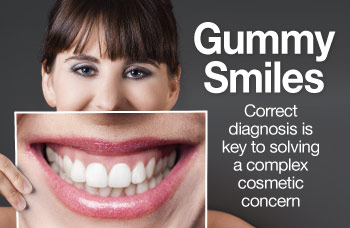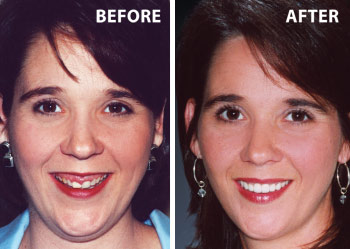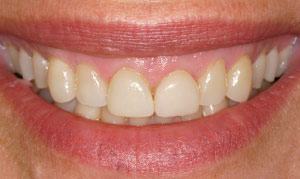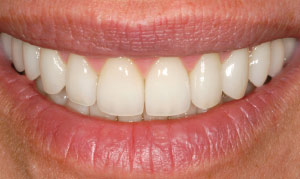Gummy Smiles
Correct diagnosis is key to solving a complex cosmetic concern

The appeal of a smile has to do with both aesthetics and perception. When people seek cosmetic dental treatment because they are unhappy with their smiles, chances are they have a legitimate problem. Some individuals' feel they show too much gum tissue or their gums are too prominent when they smile. Either their teeth appear too small, or so much gum tissue shows that the teeth are not making an impact. And a gummy smile can make a person feel self-conscious.
So what is the definition of a gummy smile? That's a matter of perception, and therefore will vary from person to person. But it has been shown that a smile will usually be perceived as gummy when four millimeters — a tad more than an eighth of an inch — of gum tissue shows.
 |
| Smiles look “gummy” when the proportions of the teeth, gum tissues, and the upper jaw are not in harmony with each other. Click to enlarge |
| Dentistry by Dr. Thomas E. Oppenheim |
Many people are not aware that there are options for correcting or altering the appearance of an excessively gummy smile. If a gummy smile impacts a person's enjoyment of life, comfort, and well-being, it could just be time to do something about it. And a lot can be done. First, your dentist will need to determine exactly why your smile looks gummy because understanding the cause always directs us towards the best solution.
The Issue Is Not Just Gum Tissue
Gummy smiles look, well, gummy, when the proportions of the teeth, gum tissues, and the upper jaw are not in harmony with each other. The position of the upper lip also plays a role. Gumminess in your smile, then, is a combination of:
- The amount of gum tissue display
- The size and shape of the teeth
- The length and the degree of movement of the upper lip
- The vertical position of the upper jaw and teeth in relationship to the skull
The Tooth And Gum Tissue “Complex”
At the heart of the matter is the proportionality of the teeth to the gum tissues. Tooth eruption is an active process by which the teeth move through the gums and supporting bone to become visible in the mouth. It usually ceases in adulthood when growth is completed and when the permanent (adult) teeth meet their antagonists (upper teeth meet the lowers in the opposing jaw).
But the process doesn't stop there; the gum and bone tissues shrink back and stabilize typically somewhere in the late teens in girls and early 20's in boys. Ideal crown length (the visible part of the tooth above the gum line) is approximately 10 mm; this is considered normal. The ratio of crown width to length is about 75-85%, which is also what is viewed as normal.
Natural variations in the eruption process can give rise to discrepancies in the normal proportions and relationships of teeth to gum tissues, which can result in shorter than normal teeth and gumminess of the smile.
 |
| When the upper teeth appear too short, periodontal plastic surgery to remove excess tissue and lengthen teeth can correct a gummy smile. |
 |
| After periodontal crown lengthening and porcelain veneers, a beautiful smile is achieved. |
| Dentistry by Dr. Elizabeth M. Bakeman |
Gumminess caused by excess gum tissue that obscures the crowns of the teeth is correctable with a periodontal plastic surgery (“peri” – around; “odont” – tooth) technique called “crown lengthening.” During this procedure, the excess gum tissues and underlying bone are reshaped to expose the full length of teeth.
Excessive tooth wear can also cause changes in the gum-to-tooth ratio. With wear, teeth become incrementally shorter. This can cause what is known as compensatory eruption, in which the teeth actually erupt (move toward the opposing teeth) very slowly to compensate for the wear; it's your body's way of maintaining a properly functioning bite with shorter teeth. In effect, this increases the gumminess of the smile because the gums, which are attached to the teeth, move with them as they erupt. It is ideally correctable with orthodontic treatment to push the affected teeth back up into correct position. This is followed by restoring the lost tooth structure with bonding or porcelain restorations.




